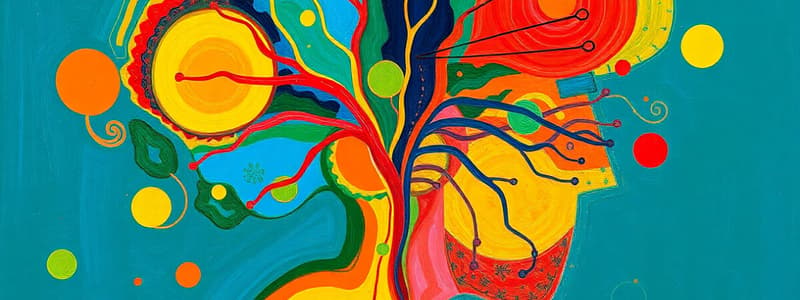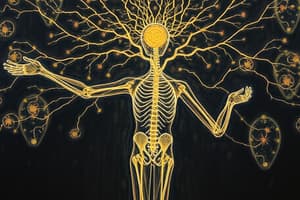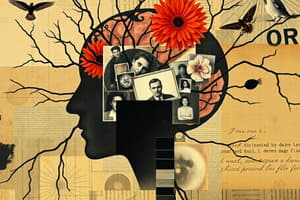Podcast
Questions and Answers
Which structure of a neuron is primarily responsible for receiving signals from other neurons?
Which structure of a neuron is primarily responsible for receiving signals from other neurons?
- Dendrites (correct)
- Axon
- Myelin sheath
- Axon terminals
What is the primary function of the central nervous system (CNS)?
What is the primary function of the central nervous system (CNS)?
- Sensitivity to external stimuli
- Integration and decision-making (correct)
- Coordination of voluntary movements
- Communication
What component of the neuron is responsible for the transmission of electrical impulses away from the cell body?
What component of the neuron is responsible for the transmission of electrical impulses away from the cell body?
- Dendrites
- Myelin sheath
- Axon (correct)
- Cell body
Which division of the nervous system is responsible for promoting rest and calming the body after a stressful event?
Which division of the nervous system is responsible for promoting rest and calming the body after a stressful event?
Which of these options correctly describes the components of the peripheral nervous system (PNS)?
Which of these options correctly describes the components of the peripheral nervous system (PNS)?
What initiates the action potential in a neuron?
What initiates the action potential in a neuron?
What role does voltage-gated sodium channels play in neuronal signaling?
What role does voltage-gated sodium channels play in neuronal signaling?
Which ion is predominantly found outside the neuron at resting state?
Which ion is predominantly found outside the neuron at resting state?
What happens during the termination of the action potential?
What happens during the termination of the action potential?
What is the function of the sodium-potassium pump?
What is the function of the sodium-potassium pump?
How does the positive feedback loop amplify the action potential?
How does the positive feedback loop amplify the action potential?
What is primarily responsible for balancing the charge inside the neuron?
What is primarily responsible for balancing the charge inside the neuron?
What causes the initial influx of sodium ions into the neuron?
What causes the initial influx of sodium ions into the neuron?
What role does the evolution of the nervous system play in vertebrates?
What role does the evolution of the nervous system play in vertebrates?
What are potential long-term effects of chronic exposure to elevated temperatures on the nervous system?
What are potential long-term effects of chronic exposure to elevated temperatures on the nervous system?
Which factor may lead to long-lasting impairments in cognitive functions?
Which factor may lead to long-lasting impairments in cognitive functions?
How does the nervous system of insects differ from that of vertebrates?
How does the nervous system of insects differ from that of vertebrates?
What can be a consequence of the global warming effects on the nervous system?
What can be a consequence of the global warming effects on the nervous system?
Which of the following describes a feature of the arthropod nervous system?
Which of the following describes a feature of the arthropod nervous system?
What is a primary evolutionary benefit of a highly developed nervous system?
What is a primary evolutionary benefit of a highly developed nervous system?
What is the expected impact of global warming on motor skills according to the content?
What is the expected impact of global warming on motor skills according to the content?
What process triggers the release of neurotransmitters from the axon terminal?
What process triggers the release of neurotransmitters from the axon terminal?
What happens to a neuron after it reaches the resting potential following an action potential?
What happens to a neuron after it reaches the resting potential following an action potential?
What initiates the electrical cycle in the next neuron after neurotransmitters bind to its receptors?
What initiates the electrical cycle in the next neuron after neurotransmitters bind to its receptors?
During synaptic transmission, what is the role of neurotransmitters in the synaptic cleft?
During synaptic transmission, what is the role of neurotransmitters in the synaptic cleft?
What is the effect of excessive potassium leaving a neuron?
What is the effect of excessive potassium leaving a neuron?
Which sequence describes the neurotransmitter release process in correct order?
Which sequence describes the neurotransmitter release process in correct order?
How does the cycle of neurotransmission ensure continuous communication within the nervous system?
How does the cycle of neurotransmission ensure continuous communication within the nervous system?
What happens to neurotransmitters after they bind to receptors on the post-synaptic neuron?
What happens to neurotransmitters after they bind to receptors on the post-synaptic neuron?
What impact do extreme temperatures have on enzymes that regulate synaptic activity?
What impact do extreme temperatures have on enzymes that regulate synaptic activity?
Which of the following is a consequence of temperature shifts for navigation in animals?
Which of the following is a consequence of temperature shifts for navigation in animals?
How does extreme heat affect ectothermic animals?
How does extreme heat affect ectothermic animals?
What kind of behavioral change is observed in animals due to temperature-related impairments?
What kind of behavioral change is observed in animals due to temperature-related impairments?
What effect can thermal stress have on an animal's learning and memory?
What effect can thermal stress have on an animal's learning and memory?
What is one effect of impaired thermoregulation in extreme conditions?
What is one effect of impaired thermoregulation in extreme conditions?
Which group of animals primarily relies on external temperatures for thermoregulation?
Which group of animals primarily relies on external temperatures for thermoregulation?
What adaptation can be observed in cnidarians like jellyfish in response to environmental changes?
What adaptation can be observed in cnidarians like jellyfish in response to environmental changes?
What effect does climate change have on the thermoregulation of marine species?
What effect does climate change have on the thermoregulation of marine species?
What challenges do marine species face with warmer waters and low oxygen levels?
What challenges do marine species face with warmer waters and low oxygen levels?
What can neural plasticity in cephalopods lead to?
What can neural plasticity in cephalopods lead to?
Which of the following is a consequence of disorientation caused by climate change?
Which of the following is a consequence of disorientation caused by climate change?
What is a 'dead zone' in the context of marine environments?
What is a 'dead zone' in the context of marine environments?
Flashcards
Central Nervous System (CNS) Component
Central Nervous System (CNS) Component
The brain and spinal cord, responsible for integration and decision-making in the body.
Peripheral Nervous System (PNS) Component
Peripheral Nervous System (PNS) Component
Nerves and ganglia, facilitating communication between the CNS and other parts of the body.
Neuron Cell Body Function
Neuron Cell Body Function
Contains the nucleus, directing the neuron's metabolic activities and protein production.
Parasympathetic Division Role
Parasympathetic Division Role
Signup and view all the flashcards
Nervous System Structure
Nervous System Structure
Signup and view all the flashcards
Action Potential
Action Potential
Signup and view all the flashcards
Sodium Channels
Sodium Channels
Signup and view all the flashcards
Ionic Gradients
Ionic Gradients
Signup and view all the flashcards
Sodium-Potassium Pump
Sodium-Potassium Pump
Signup and view all the flashcards
Resting Potential
Resting Potential
Signup and view all the flashcards
Positive Feedback Loop
Positive Feedback Loop
Signup and view all the flashcards
Termination of Action Potential
Termination of Action Potential
Signup and view all the flashcards
Voltage-Gated Channels
Voltage-Gated Channels
Signup and view all the flashcards
What is synaptic transmission?
What is synaptic transmission?
Signup and view all the flashcards
What triggers neurotransmitter release?
What triggers neurotransmitter release?
Signup and view all the flashcards
What is the function of neurotransmitters?
What is the function of neurotransmitters?
Signup and view all the flashcards
What is hyperpolarization?
What is hyperpolarization?
Signup and view all the flashcards
Depolarization
Depolarization
Signup and view all the flashcards
Repolarization
Repolarization
Signup and view all the flashcards
Arthropoda Nervous System
Arthropoda Nervous System
Signup and view all the flashcards
Advanced Ganglionic Nervous System
Advanced Ganglionic Nervous System
Signup and view all the flashcards
Evolution of Nervous System
Evolution of Nervous System
Signup and view all the flashcards
Thermal Stress on Nervous System
Thermal Stress on Nervous System
Signup and view all the flashcards
Chronic Exposure to Elevated Temperatures
Chronic Exposure to Elevated Temperatures
Signup and view all the flashcards
Long-Term Effects of Heat Stress
Long-Term Effects of Heat Stress
Signup and view all the flashcards
Neural Inefficiency
Neural Inefficiency
Signup and view all the flashcards
Impaired Decision-Making
Impaired Decision-Making
Signup and view all the flashcards
Temperature Sensitivity of Enzymes
Temperature Sensitivity of Enzymes
Signup and view all the flashcards
Ectothermic Animals and Temperature
Ectothermic Animals and Temperature
Signup and view all the flashcards
Navigation Disruption by Temperature
Navigation Disruption by Temperature
Signup and view all the flashcards
Cognitive Impairment due to Heat
Cognitive Impairment due to Heat
Signup and view all the flashcards
Thermoregulation Challenges
Thermoregulation Challenges
Signup and view all the flashcards
Simple Neural Plasticity in Jellyfish
Simple Neural Plasticity in Jellyfish
Signup and view all the flashcards
Cephalopod Adaptability
Cephalopod Adaptability
Signup and view all the flashcards
Climate Change Impact on Disorientation
Climate Change Impact on Disorientation
Signup and view all the flashcards
Neural Plasticity's Role
Neural Plasticity's Role
Signup and view all the flashcards
Adaptability to Dead Zones
Adaptability to Dead Zones
Signup and view all the flashcards
Reduced Coordination and Movement Patterns
Reduced Coordination and Movement Patterns
Signup and view all the flashcards
Study Notes
Nervous System
- The nervous system is the principal control and communication system in animals.
- Enables perception of stimuli, coordinating responses and integrating bodily functions.
- Crucial for survival, adapting to the environment, and maintaining homeostasis.
- Contains specialized sensory receptors like mechanoreceptors, photoreceptors, chemoreceptors, and thermoreceptors.
Key Functions
- Sensory Input: Detecting changes in the environment (internal or external).
- Integration: Processing and interpreting sensory information.
- Motor Output: Activating muscles or glands to produce a response.
- Homeostasis: Maintaining stable internal conditions.
- Behavioral Regulation: Controlling behaviors for survival and reproduction.
Sensory Input
- Detecting changes in the external or internal environment (light, sound, temperature, touch).
Integration
- Processing and interpreting sensory information.
- Determining the significance of sensory input.
- Interpreting the meaning of information.
- Deciding appropriate responses based on context.
Motor Output
- Activating muscles or glands to produce a response based on sensory input and integration.
Subconscious Integration
- Automatic responses (reflexes) to stimuli not requiring conscious thought.
- Primarily regulated by the brain and spinal cord.
Conscious Integration
- Voluntary responses, requiring conscious thought and control.
- Involving the higher brain regions, such as the cerebral cortex.
Voluntary Motor Output
- Conscious control over movements.
- Regulated by the somatic nervous system.
Involuntary Motor Output
- Automatic responses not requiring conscious control.
- Regulated by the autonomic nervous system.
Homeostasis
- Maintains stable internal conditions despite external changes (e.g., body temperature, blood pressure).
- Example: Sweating to regulate body temperature in a hot environment.
Behavioral Regulation
- Controls behaviors to ensure survival and reproduction based on instinct, learning and complex behaviors.
- Example: Developing sexual desires at maturity.
General Structure of the Nervous System
-
- Central Nervous System (CNS): Contains the brain and spinal cord, acting as the control center.
-
- Peripheral Nervous System (PNS): Connects the CNS to the rest of the body.
Central Nervous System (CNS)
- Contains the brain and the spinal cord.
- Responsible for processing sensory information and coordinating responses.
- Protected by the skull and vertebrae.
Peripheral Nervous System (PNS)
- Connects the CNS with the rest of the body.
- Ensures seamless communication, coordination, and regulation of bodily functions.
Components of the CNS (Brain)
- The most complex organ in the body, divided into regions that control distinct functions.
- Consists of billions of neurons and glial cells.
Forebrain
- Cerebrum: For higher cognitive functions, sensory perception, and motor activities.
- Thalamus: Relays sensory and motor signals in the cerebral cortex.
- Hypothalamus: Controls homeostasis.
- Limbic System: Governs emotions, memory, and motivation.
Midbrain
- Acts as a relay station between sensory input and motor output.
- Contains structures like the tectum and tegmentum.
Hindbrain
- Also known as rhombencephalon.
- Controls fine motor coordination, balance, and posture (cerebellum).
- Involved in regulating breathing and heart rate (medulla oblongata).
Cranial Nerves
- 12 pairs of cranial nerves that perform specialized functions, such as controlling eye movement and other bodily functions.
Spinal Cord
- Responsible for conveying messages between the brain and peripheral nerves, coordinating voluntary and involuntary responses.
- Serves as a communication highway between the brain and the body.
Functions of the Nervous System
- Signal Transmission
- Reflex Actions
- Independently
- Responses
- Most reflexes does not reach the brain
Anatomy of the Nervous System
- Gray Matter -Butterfly-shaped -Contains neuron cell bodies
- White Matter -Outer region -Composed of myelinated axons -Conducts signals
- Spinal Nerves -Paired nerves -Emerged from the spinal cord -Motor and sensory functions
Neurons
- Are position in your body
- Communicate through axons and dendrites
Types of Neurons
- Unipolar
- Bipolar
- Multipolar
- Pseudounipolar
Synaptic Transmission
- The process whereby neurons communication with one another and with effectors such as muscles and glands.
- Electrical and chemical process.
Studying That Suits You
Use AI to generate personalized quizzes and flashcards to suit your learning preferences.




